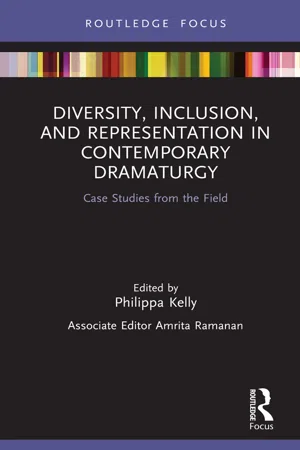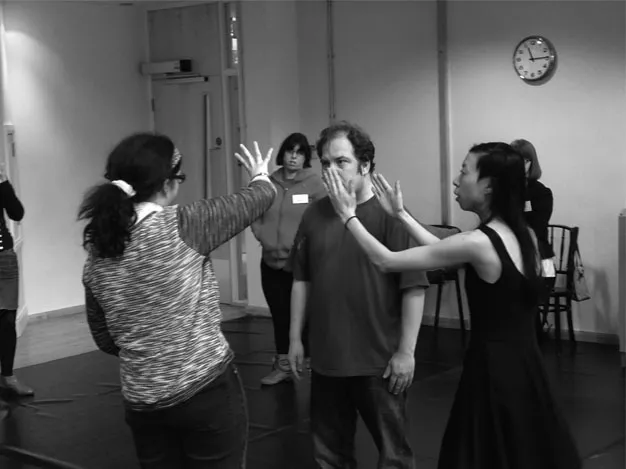The neurodiversity movement has led to a shift in approach as researchers concede to a growing and increasingly powerful distinctive discourse of autism rights, social justice, and refections on the creative aspects of autism.7
Frontiers
There’s a frontier or border you have to cross to work transnationally. Euphemistically, if you’re crossing a line, you’re doing something a bit naughty, a bit forbidden – and if you’re working with learning-disabled artists, you’re frequently doing that in terms of any so-called mainstream aesthetic. “Crossing The Line” as a term gives a nod to shot rhetoric in the film world.8 Cinematographic convention suggests that two characters in a scene should maintain the same left/right relationship to one another in the frame. If you want to disrupt the spectator’s understanding of what they’re seeing, then you cross that 180-degree line.
In the socializing area in the Mind The Gap building in Bradford, the TV plays images from the guest companies’ productions so that as they arrive the companies’ participants can see themselves and their colleagues. Mind The Gap (MTG) Resident Director Joyce Nga Yu Lee introduces the opening session in Bradford by stating that in Hong Kong a teacher described theater as a collaborative risk in action. It is in this spirit that she launches the first Crossing The Line workshop. Lee approaches the difficulties of translation with a creative flourish, jumping over the issue of comprehensibility by running the session in Cantonese – among those present, a language that only she understands. This is of course combined with visual clues. The creative challenges of access for learning-disabled artists, as well as those of translation, are immediately connected in our minds. Each requires a practical, dramaturgical strategy. By equalizing all participants’ access with this choice of Cantonese, the session works very effectively.
Lee then deploys Tim Wheeler’s9 “Two By Three By Bradford” version of an Augusto Boal game. In pairs, participants begin counting: one, two, three – each partner says one number at a time. Once this has been mastered, the count number one is replaced with a sound. Then count number two is replaced with a physical action. Then count number three is replaced with a sound and a physical action. Then the exercise is rerun with the whole group standing in a circle. The artists engage with permission to be seen, gestures, and moving images. Stories emerge, but their narrative is created in the minds of those watching from the side (the audience).
In the next day’s session, Mind The Gap Guest Director Alan Lyddiard draws on Boal but also on Kantor and his own wealth of experience as theater director and community theater-maker to welcome participants into a workshop that will feed the Contained Development process.10 “I want to be like somebody else once was” is the opening line of Peter Hand-ke’s Kaspar.11 The play depicts a near-speechless young man destroyed by society’s attempts to impose on him its language and its own “rational” values.12 In the Bradford rehearsal workshop the line is also deployed in French – “Je veux etre quelqu’un d’autre qui a été.” This sentence is adopted by Lyddiard and becomes an individual and collective rhythmic chant. As a dramaturgical signifier for theater-making, the process deliberately selects and then rejects what is widely understood as a play (text) and repurposes the opening line away from its readily yielded meaning to become a tool for another kind of theater (and meaning)-making: one that might combine sounds or textures of individual and collective Swedish, French, English….
Lyddiard’s slow walking builds layers through physical, simple movement sequencing. Daily morning warm-up exercises are given, as Lyddiard articulates it, “authentically – completely – sincerely” (all slippery words, to use Hargrave’s phrase, in any language). There is rooting/routing the performers to/through the space, each other, and themselves, and live music runs alongside. Jez Colborne (Mind The Gap resident artist) extemporizes on the keyboard. This serves to anchor, steer, and underscore. Individual, personal stories begin to emerge from the participants, with Lyddiard refining what works and what doesn’t. Next, Lyddiard adds technology: screens, microphones, and video cameras. These allow the generation of snippets: slow walking, stories to microphone, the moving of the screen and cables – three things going on at the same time. Starting with the personal stories, the action picks up pace, with the performers developing awareness of others in the space, as yet seemingly in a random order. Lyddiard watches, assesses, then creates further instructions that focus on the newly emerging performance text: timing, refining, picking up the process again. There is room for a different original creative contribution, this time in French, from Compagnie de l’Oiseau-Mouche performer Thierry Dupont. Simply stated emotions work with the material that is generated: the build is iterative, recursive. Lyddiard’s session concludes with the entire sequence run, so everyone has a sense of what has been attempted and accomplished.
Hargrave introduces the notion of dis-precision, which can be understood as a disruption that allows an extra dimension in perspective: “little tear marks in the performance where the audience is able to see the joins created in rehearsal: the blocking that’s been learned through repetition. ‘Seeing the join,’ a continuous deconstruction between the performer and the text …”13 Here Hargrave is positing the need for a reconsideration of the actor’s craft, away from a more conventionally understood conservatoire training in relationship to how an audience might engage with such a performance. Lyddiard makes the distinction between “actor” and “performer,” preferring the latter as a term to describe a process of the people onstage self-presenting. With the very personal snippets of performers’ stories created through this process of assemblage, the effect of the final production on the spectators shifts between Brechtian presentation to the post-dramatic. The title “Contained” rather elegantly illustrates the paradox here, as a consistent reading won’t hold.
The Mind The Gap (MTG) Ambassadors, drawn from the company, have been working throughout the four days, welcoming, hosting, explaining, and asking questions of visitors. In their final session, they use MTGTV recording as a tool both for creative engagement with the guests and for developing specific skills to allow for reflection on what has been the participants’ experiences.
What happens to territory if the center is everywhere?
The Mind The Gap decision to combine this opening artist residency with an industry-facing day-long symposium (March 2015) allowed the work to be linked to its cultural context(s): raising questions, providing challenges, and opening up the process and the discourse to the three companies and around eighty industry professionals and academics.
The history of U.K. performance in regard to physically and/or sensorially-disabled artists is not congruent with the history of their learning-disabled counterparts. They may share similar values, but the discourse(s) in the U.K. around the former can tend to occlude the latter. Hargrave identifies learning disability as “an unstable category that stands for a range of complex social processes.” He defines the subject of his book as “theater involving the collaboration of learning-disabled artists, which articulates a process rather than a fixed point.”14
In the workshop the day before, performer/musician and Mind The Gap resident artist Jez Colborne told me that sirens are “different”: differently powered. Some work with engines; some are powered by air. Each country might choose the one they think most powerful, but they all have varying pitch and tone. (Colborne is something of an expert on sirens, and his fascination with them led to the 2012 Mind The Gap show Irresistible, described as a siren symphony.)
“Perhaps universal history is the history of the various intonations of a few metaphors,” Borges concludes in his 1951 essay/note, “Pas...

